Tag: #HDBguidelines
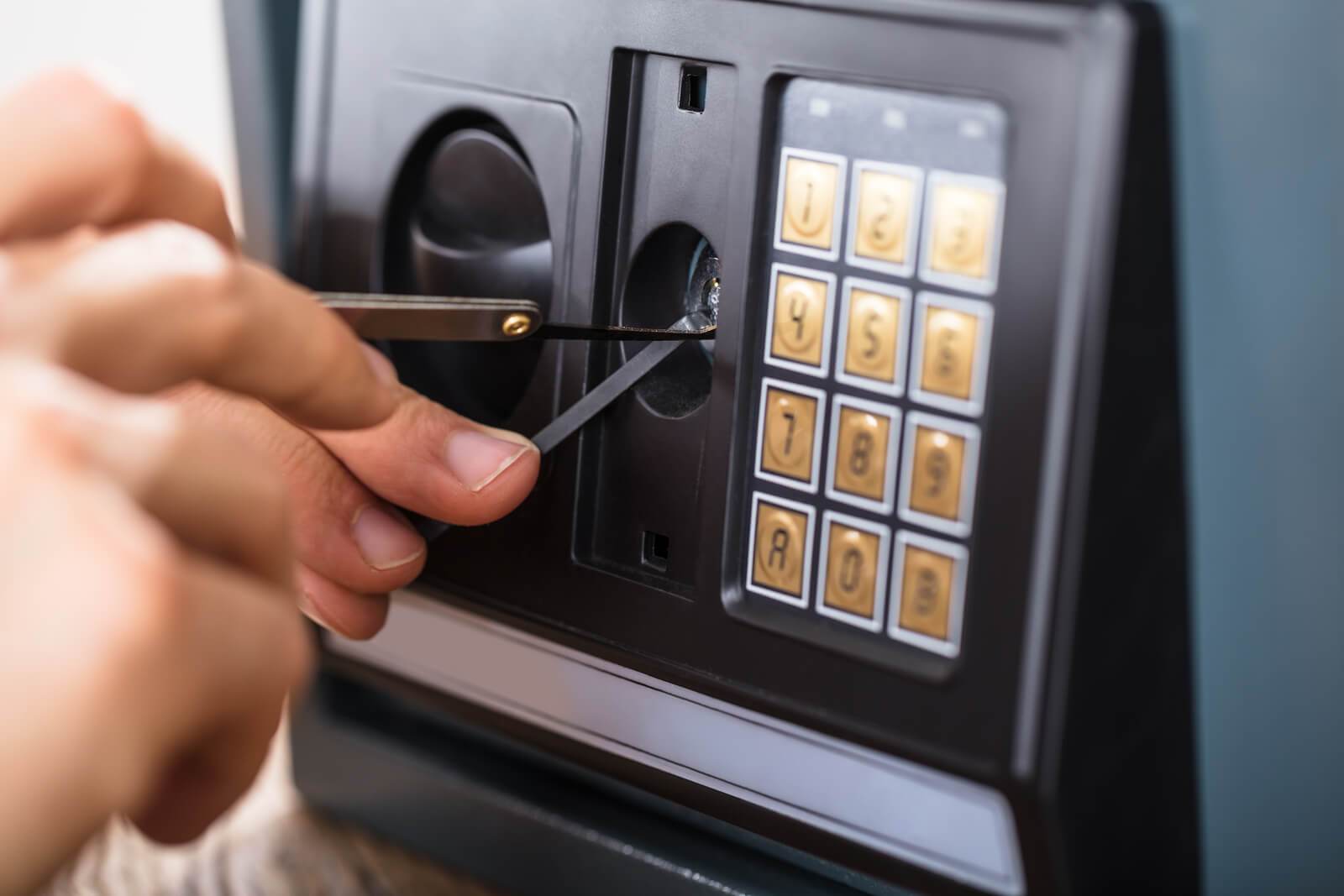
An Easy Model To Understanding HDB’s Machinery/Equipment Installation Guidelines
The HDB guidelines have always been there to guide every aspect of construction and renovation in Singapore. From building works, electrical, mechanical, sanitary and even air conditioning, these guidelines cover each and every side of a renovation that could later cause problems to the residents of a building. This is why every interior design company in Singapore has to carefully follow these guidelines very specifically.
The Singapore Housing Development Board is very particular about maintaining the overall structural and aesthetical integrity of their architecture. Therefore, they’ve written some clear-cut rules when it comes to the installation of even miscellaneous items such as machinery and equipment in any building. Further, we’ll be looking at the guidelines that every interior design company in Singapore has to respect with respect to these items.
1. Machinery/Equipment Installation
There are some strict requirements to follow when the machinery or equipment you’re installing in the building weighs more than 400kgs. Let’s look at some major things you need to know:
– In case your machine/equipment weighs less than 400kg, you will not have to apply for a permit granted that you do not obstruct any inbuilt fire-fighting escapes or equipment’s.
– However, if your machinery weighs more than 400kg, you’ll definitely have to apply for an HDB permit.
– Furthermore, you’ll have to hire a Qualified Person to conduct a structural analysis. They will calculate the requirements to create uniformly distributed weight and its execution.
– Keep in mind that this machinery/equipment should not overload a structure.
– These machines should also be shock absorbent and their noise should be dampened.
2. Chiller Room Installation
A chiller room is where all the cold storage is carried out. Any respectable interior design company in Singapore will tell you that very specific structural as well as permissive aspects have to be followed for the installation of a chiller room.
– First off, you’ll have to get a permit from the requisite HDB authorities.
– After that, a properly drafted drawing has to be submitted to the authorities that will indicate the location, dimension and the total operating weight of the chiller room.
– A Qualified Person would have to create a structurally sound proposal that will ensure that the total imposed load is less than existing floor imposed load. If not, then a reinforced concrete plinth or a steel base will have to be installed.
– Proper drainage and discharge traps will have to be installed into the chiller room. For more details, you can go through the official HDB guidelines.
3. Cooling Tower Installation
A cooling tower is the accompanying equipment of your Air Conditioning Units. It is usually installed on the rooftop and is out of sight. According to the HDB guidelines, you’ll have to get endorsement from the HDB authorities as well as the Singapore Civil Defence Force’s Fire Safety & Shelter Department (SCDF FSSD), and Building and Construction Authority for the installation of cooling towers.
4. Safe Installation
If you’re looking to install a safe in your home or even office, then getting a permit completely depends on the weight of the safe. If your safe weighs more than 400kg, only then will you have to apply for an official HDB permit.
– If the safe is less than 400kg in weight, then aside from a few obvious rules you will not be subject to apply for a permit granted that you do not block off the firefighting equipment and escape route.
– But if the weight of your safe exceeds 400kg, you’ll have to hire a Qualified Person to conduct a structural analysis who will deliver solutions to equally distribute the load of the safe. Every interior design company in Singapore is aware of these setbacks and works with them accordingly.
5. Car Lift/Car-o-Liner Installation
Anyone looking to install a building oriented Car Lift or Car-o-Liner has to get a permit from the requisite HDB authorities. Here’s all you need to know about it:
– You’ll have to stringently follow the structural requirements.
– The catalogues, along with the size and dimensions of the lifts would have to be submitted.
– A Qualified Person would be hired to carry out an existing structural analysis, and then provide an alternative structural stability strategy for the installation.
– Overloading the structure is definitely out of the question.
– In case of installation of a hydraulic car-o-liner, you would have to get a permit from the HDB along with the BCA authorities.
Home Guide Design has been in the industry long enough to understand and value the importance of these guidelines. Our company is well versed in all the minutiae’s and will save you a lot of time trying to manage everything on your own.
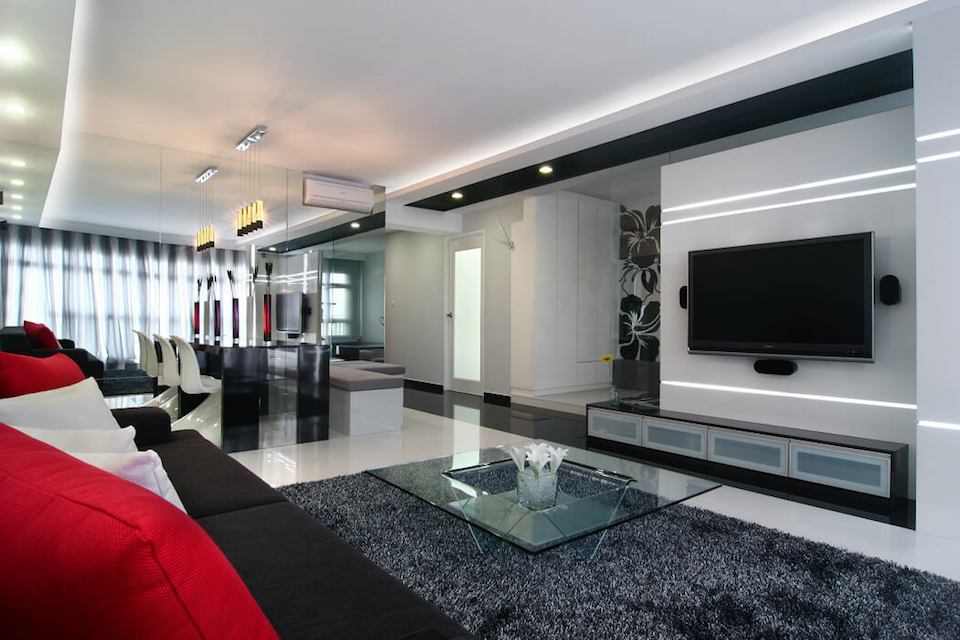
An easy guide to understanding the Air-Conditioner Installation Works HDB Guidelines!
The HDB guidelines are the gospel of every interior design company in Singapore. They are the rules set out by the HDB authorities that ensure a successful renovation for all residential building works in the country. These cover everything ranging from physical renovation ‘building works’ to electrical, mechanical, sanitary/plumbing and even air-conditioning.
Today we will be looking at everything that you must know about installing air-conditions in your HDB allotted homes. Interior design in Singapore is designed to accommodate the humid climate, which is why air-conditioning is especially important. Below, we’ll be providing an easy to understand guide of the official rules you must follow.
1. Condensing Units
Condensing units are the ‘split’ type air conditioners that do not require extensive ductwork. Here’s all you should know about installing one in your home.
– No, you do not need an HDB approved permit to install 2 or less condensing units given that their combined weight is less than, or equal to 110 kg.
– This is only permissible within the designated air-conditioner platform or a service yard, the total weight of which should not exceed more than a 150 kg/m2 and given that it is installed on the floor slab of the service yard.
– These air conditioning units (ACU’s) should have an outlet that is outside the units premises. It should also have a minimum height clearance of 2.4 m from the finished floor level of the corridor.
– You must not damage any existing structural members during the installation of your ACU.
– The ACU must rest on stainless steel wall-mount supporting brackets.
– The guidelines dictate that the installation should be carried out by the Building and Construction Authority’s licensed air-conditioner installer. This is why every interior design company in Singapore is affiliated with such a contractor.
– No window type unit is allowed for danger of falling off.
– All the condensation water should be properly discharged into the designated floor trap.
For all the ACU’s weighing more than 110 kg, you would need to get an official HDB permit for installation. Here is a list of all the auxiliary guidelines you must follow:
– The structural requirements are very stringent. Interior design in Singapore is extremely liable to these guidelines, so they should be followed accurately.
– Since every brick wall panel can only handle a single 110 kg ACU, make sure that no more than one unit is installed on each wall.
– A qualified person (QP) should be hired to carry out the working and installation of these ACU’s. He’ll have to draft the structural details, carry out the calculations and notify of all the specifications that do not comply with the Seventh Schedule of the Building Control Act and Regulations (2004).
– These plans would clearly show the location of all ACU’s, their fan-coil units along with the refrigerant and the discharge pipes.
– All the structural calculations of the air-condensing bracket installation that do not comply with the Seventh Schedule of the Building Control Act and Regulations (2004) must be submitted to the relevant authorities for approval.
– There should be no harm done to the original structure of the building during installation.
– To understand the nitty-gritty of your ACU installation process, we’d suggest you go through the official HDB guidelines at least once.
2. Air Cleaners
Air cleaners come with ductwork that has to be installed in the space between the false ceiling and the actual ceiling. Despite many residents preferring the ACU’s for their interior design in Singapore, there are still some that want air cleaners. Here is all that you should know about installing it:
– No, you do not actually need an HDB approved permit to install your air cleaners given that its weight is less than 35 kg.
– None of the ductwork for the air cleaners should harm the existing structural details (i.e. columns, beams, etc.).
– Make sure that your air cleaners do not hang suspended from the ceiling. Instead, they should be suspended from a professionally designed steel structure supported by the existing reinforced concrete columns and beams.
– Also note that the penetration of nuts and anchors should be only 40 mm into the existing slab.
– Make sure that the air cleaner does not block any window view, and that all exhaust air be collected and treated with muffles to avoid noise or smell before discharge.
– All kitchen exhaust systems require the endorsement of HDB authorities and approval from the Singapore Civil Defense Force’s Fire Safety & Shelter Department and National Environment Agency.
Now, let’s look at the HDB guidelines for the installation of air-cleaners that weight more than 35 kg.
– Yes, you will need an official HDB authorized approval for all air cleaners that weigh more than 35 kg.
– The structural requirements for their installation in any interior design in Singapore is very stringent. You’ll have to hire a Qualified Person (QP) who will submit all calculations, connection details, structural drawings in a detailed plan to the relevant authorities.
– Furthermore, the air-cleaners will be suspended not from the ceiling, but from the steel members spanning the existing reinforced concrete structure of columns and beams. Also note that no anchor or bold should penetrate more than 40mm in the existing slab.
– Note that all the discharged air should be first treated with the muffles to get rid of the noise and smell and no exhaust face will block the window view.
– Lastly, the installation of every kitchen exhaust system should have the appropriate endorsement of the HDB and approval should be sought from the relevant authorities.
As you can see, there are a lot of small rules and regulations to be followed for this particular technical aspect of the renovation. Since Home Guide is an experienced and renowned interior design company in Singapore, we can help you get your feet off the ground and get you all the right permits with little to no hassle at all!
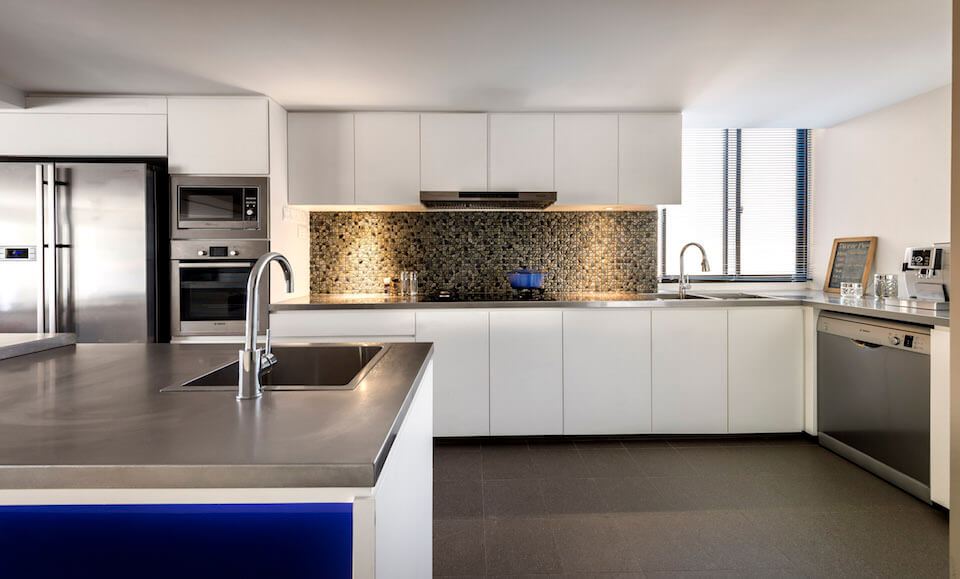
Understanding The HDB Guidelines For Sanitary, Plumbing & Gas Installation in Easy Ways!
Every Singapore resident is aware – or has at least heard in passing – of the HDB guidelines. These are an extensive list of all the rules and regulations that all homeowners have to abide by during the renovation or construction phase of their homes.
Interior design in Singapore is a booming industry, and every firm in the market is affiliated with HDB approved contractors that will make your renovation easy. But did you know that these guidelines do not only cover the building works that make up the renovation? They consist of electrical, mechanical and even sanitary/plumbing works.
These are definitely an underrated part of the renovation process, but something without which any home design is incomplete. So below, we will be looking at the Sanitary/Plumbing and Gas installation guidelines in detail.
1. Water Pipes & Points
The installation, positioning and workability of water pipes and points is an important part of every renovation project. Every interior design company in Singapore will provide you with detailed drawings for sanitation and plumbing.
Here’s what you should know about it:
– You do not need a permit for the replacement and/or addition of water pipes and points from the HDB authorities.
– All installation, repositioning and replacement works shall comply with the National Environment Agency requirements.
– There should be no damage or hacking of the existing floor slabs and structural members during this process.
– All of this work should be carried out by a licensed plumber. You’ll find that every interior design company in Singapore is affiliated with one or more.
2. Repositioning of Sink & Wash Basin
Home interior design in Singapore is especially relevant to small details like bathroom and kitchen designs. Thus, the repositioning of sinks and wash basins is extremely important. Here’s all that you should know about it:
– No, you do not need an official HDB approved permit to reposition your sink or wash basin.
– All of the work carried out should comply with the National Environment Agency requirements.
– Note that all the water should be discharged into the existing floor traps.
– Any new sinks or wash basins to be installed should be positioned in the existing wet areas.
– None of the existing outlets should be tampered with.
– Remember not to damage any existing floor slab or structural membrane.
– The diameter of the discharge pipes in the floors should not exceed 35 mm. the overall thickness of the floor finishes including the slab, pipes, screed and tiles should not exceed 50 mm.
3. Installation of Portable Grease Trap
For all those how do not know, the grease trap is a plumbing device that stops all greasy and solid wastes from entering the waste-water disposal system. Interior design companies in Singapore would be affiliated with contractors who can carry out such works. Here’s what you should know about the installation of grease traps:
– You do not need an HDB authorized permit for installing a new, portable grease trap, given that its total operating weight – including the self-weight – is less than 400 kg. This installation should not tamper with the 1.2 m fire escape route. It should also have a 600 mm clearance from the firefighting equipment.
– For the installation of a portable grease trap with more than a 400 kg total weight, you do need an HDB approval. A Qualified Person (QP) would also provide full calculations for the load distribution of all the relevant machinery and equipment on the existing floor slab for approval. If it doesn’t meet the requirements, then the QP would design the plinth and steel plate to spread out the weight of this equipment.
– You will need an HDB approved permit for the installation of a new grease trap. You will also need the endorsement of the Building Construction Authority and National Environment Agency.
Plumbing and sanitary works can be especially challenging to take care of without the help of a professional consultant. Home Guide prides itself as one of the best interior design companies in Singapore, and we can help you take care of all technical aspects without any hassle at all.
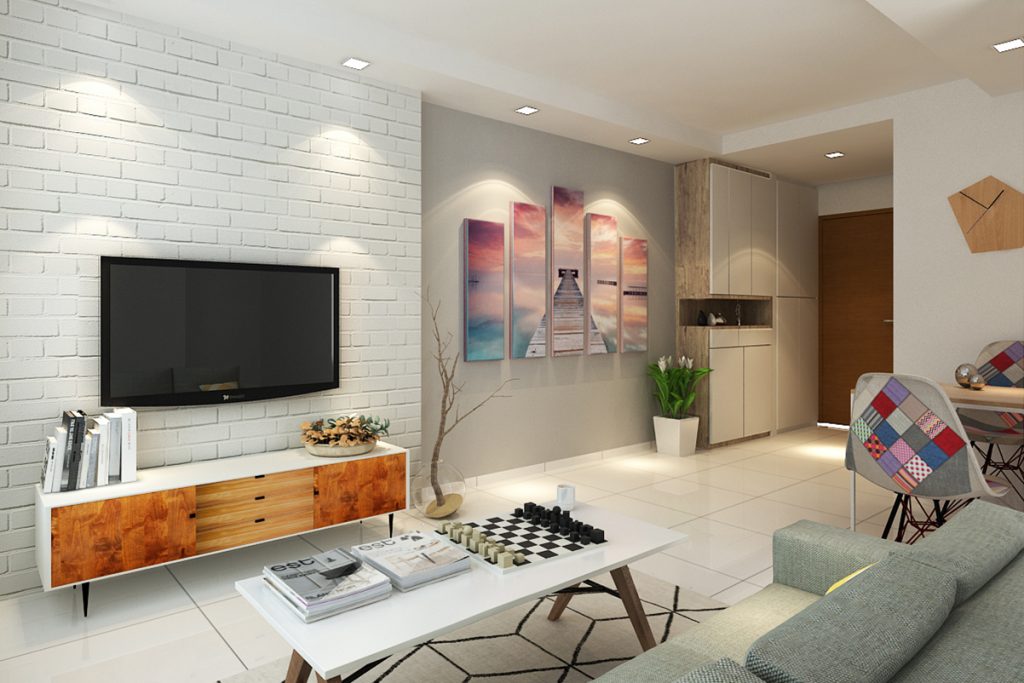
An Easy Guide to Understand the HDB Electrical Guidelines
Everybody who lives in Singapore must be familiar with the HDB (Housing Development Board) Authorities and their guidelines. These are extremely important to know, especially if you’re dabbling with interior design in Singapore. All HDB guidelines are related to many genres of renovation works that you must get done in order to fully refurbish your house. Every interior design company in Singapore must be familiar with these guidelines.
Electrical works consist of all networks of electricity supply – whether you wish to upgrade to install new connections or even rewire. HDB has laid out an extensive guideline for you to follow while getting your electrical works done during a home renovation. Let’s take a look at all the things you should know about this specific genre of renovation.
1. Application for HDB Endorsement for New Electrical Supply
First of all, you or any interior design company in Singapore that you hire will have to fill out an application for HDB endorsement for a new electrical supply if you wish to start from scratch. We’re going to explain through a step-by-step guide about how you can get an HDB endorsement for a new electrical supply.
– The very first thing you should know is that you have to get an HDB certified permit for new electrical networking in your renovation.
– Note that the HDB endorsement is needed for the application you fill out for SP Services Ltd. This is a leading energy utility company that owns and operates electricity and gas transmissions in Singapore.
– After this, you will hire a licensed electrical worker (LEW), who will submit all relevant single-line drawings, CS5 or CS7 to the SP Services and HDB authorities in order to get an endorsement. Almost every interior design company in Singapore is affiliated with one.
– After the approval of electrical works drawings from the authorities, the LEW becomes fully responsible for all electrical installations and must make sure that any additional rewiring doesn’t exceed the approved electrical load of the premises.
– HDB even has a list of licensed electrical works contractors on their website. You can browse from there.
– Note that your LEW is in charge of all electrical works, and he can get HDB as well as SP services approval by submitting the drawings to the authorities via this email address: ipgmail@mailbox.hdb.gov.sg.
2. Application for HDB Endorsement to Upgrade Electricity Supply
Every interior design in Singapore is customized to the needs of the user. This means that even electrical works can need an upgrade to fit the design. So you need an HDB endorsement to upgrade from the original electrical design load. Here’s how you should go about that:
– First off, you’ll need to apply for an HDB approved permit to upgrade the electrical works.
– Given the approved permit, all registered industrial tenants can upgrade the existing electrical load to a higher one.
– For residential settings, you have to appoint a licensed electrical worker (LEW) who will download, fill-up and submit all relevant forms and drawings to the HDB authorities for approval through CORENET-ESS.
– After that, the LEW would make payments to the authorities and collect the endorsement. This endorsement form would be submitted to the SP Services for approval.
– At the end, the clients LEW would meet with the HDB appointed LEW to inspect and turn-on the electricity supply.
– Not that the upgrading fee is based on the current upgrading charge, i.e., $45 per additional ampere for rentals and $85 per additional ampere per phase.
Home Guide designs is one of the leading interior design companies in Singapore, and is therefore affiliated with the right LEW’s. Working with us can certainly make your electrical works easy to deal with!

An Easy Guide for Understanding HDB’s Mechanical Works Guidelines
As you know, every interior design in Singapore is regulated by the HDB authorities and their official guidelines. These guidelines cover a vast array of all sorts of construction work ranging from building renovation works, electrical works, mechanical works, plumbing/sanitary works and more. These guidelines ensure not only the safety of the residents but also the building they live in.
Today, we’re going to take a closer look at all you need to know in order to successfully install mechanical works according to the HDB guidelines. But first, let’s elaborate a little on what mechanical works actually area. Interior design in Singapore refers to fire alarms, smoke detectors and sprinklers systems as the mechanical works of a building. Below, we will be looking at the HDB guidelines that you must follow for the successful installation of these works.
1. Installation of a manual fire alarm system
A manual fire alarm system is one where the location of hose reels and fire extinguishers matter the most. It has some very stringent specifications that need to be strictly followed. The installation of a manual fire alarm system also considers the relocation and additions of the hose reel and extinguishers.
In terms of interior design in Singapore, these are especially relevant. So you should know that if you want to install a manual fire alarm system, you must first get a permit from the HDB authorizes. Furthermore, you must also get endorsement from the Singapore Civil Defence Force’s Fire Safety and Shelter Department.
2. Installation of an automatic fire alarm system
An automatic fire alarm system consists of a digital interface as well as automatic sprinkler systems. Its installation requires input from trained professionals, so the HDB authorities definitely has guidelines that you must follow in order for you to install this system.
First and foremost, you must get the endorsement and permit from the HDB authorities to get an approval for installation. Secondly, you must get the approval from the Singapore Civil Defence Force’s Fire Safety and Shelter Department in order to successfully install your automatic fire alarm systems.
3. Installation of kitchen exhaust systems
The proper ventilation of kitchen is extremely important. This requires the installation of either a flue chimney, a vent pipe, or an exhaust hood. All interior design companies in Singapore have to get a stringent HDB approval in order to install these exhaust systems. You will need to get an official permit from the HDB authorities, along with an endorsement and approval from the Singapore Civil Defence Force’s Fire Safety and Shelter Department and National Environment Agency.
4. Installation of air-conditioning and ductwork
Interior design in Singapore is designed to accommodate the tropical climate of the country, which means that air-conditioning is a very important part of it. Therefore, air-conditioning and mechanical ventilation systems that involve ductwork have become so ubiquitous that HDB requires an official permit to be approved in order for you to get it installed. You would also need the approval of Singapore Civil Defence Force’s Fire Safety and Shelter Department and National Environment Agency for successful installation.
Now that you know about all the pre-requisites of installing your mechanical works, you should also know that these are some very generalized guidelines. HDB authorities have an officer-in-charge in every other area, whom you can consult for individual circumstances and situation. Home Guide is an officious interior design company in Singapore and is affiliated with the best mechanical works contractors. Working with us would definitely spare you all the hassle that comes with these technical aspects of every home renovation!
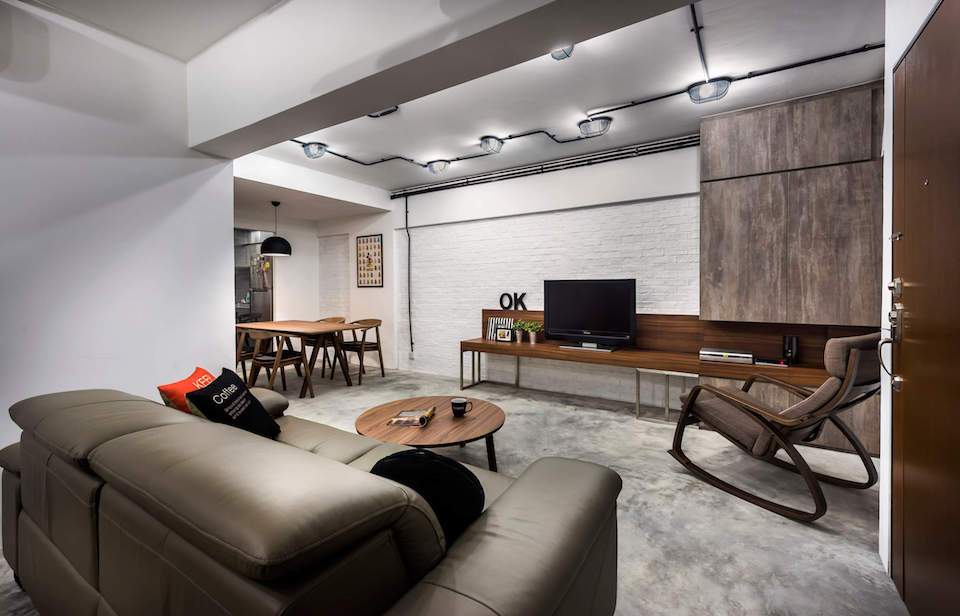
HDB Renovation Guidelines Demystified
You might have heard of the HDB guidelines in passing especially if you’re thinking about buying a new home, or renovating your old one. HDB is an abbreviated form of the Housing Development Board in Singapore. This authority is responsible for allocating flats and apartments to the Singapore residents on a temporary lease.
Thus, when you get your own apartment/flat and are looking for the best interior design services in Singapore, it might be a good time to acquaint yourself with the basics of the HDB Renovation Guidelines. These tell you all the measures you should take during the process of construction. There are guidelines for simple building works, including ceiling design, wall construction, door and window schedules and more.
Further, we are going to compile a simple list of all the major guidelines you have to keep in mind while hiring an interior design company in Singapore.
– Building works
Building works refer to the major, physical renovation aspects of a home interior design in Singapore. These include all the major components that have to be added or subtracted from the existing interior design. Let’s take a brief look at all the building works and their respective guidelines that you should know about.
a. Ceiling: The ceiling design HDB guidelines tell you about the clear height of the false ceilings, how it should be bolted into the existing structure and what to do with the space in between. They also specify the clear height of the fan from the finished floor, along with its recommended weight.
b. Doors: The door design guidelines specify about whether or not you need a permit to replace an existing door or close up an existing entrance/exit, the standard dimensions of exit doors and where not to open doors in public areas.
c. Windows: Like doors, the window design guidelines dictate whether you can replace the HDB sanctioned windows, if you need permits to enlarge or close them up, and if you can replace the grills and other paraphernalia or not.
d. Floors: Floor design HDB guidelines tell you the exact thickness of floor finishes and what kind of authorized treatments are a must after installation.
e. Walls: Any home interior design in Singapore or all over the world is incomplete without walls. The HDB guidelines specify when you need a permit for demolition and construction of existing walls.
f. Storage: The guidelines for storage units determine the size and dimensions of the racks. They also tell when you should get a permit for
g. Signboards: the building works guidelines also tell about the sizes and dimensions of signboards and advertisements. The sanction the ratio area for advertisements, as well as the recommended structural support for the signboard.
h. Awnings: The HDB guidelines specify where you are allowed to put up awnings outside your homes.
– Electrical
Electrical works include the wiring of lights, air-con units, switches and more in a home interior design in Singapore. The HDB guidelines about electrical works tell you the process of what you need to do if you’re looking for a new electricity supply. They also tell what you need to do in order to get an upgrade on your already existing electricity supply. The guidelines offer a step-by-step scenario of all the things you must do for either of these situations.
– Mechanical
All the firms and contractors who offer mechanical interior design services in Singapore must abide by the HDB sanctioned guidelines. Mechanical works include the installation of automatic fire alarm and sprinkler systems, installation of ventilation/exhaust pipes and HVAC (Heating, Ventilation & Air Conditioning). The HDB guidelines specify when you need permits and whose endorsements you should apply for to get your mechanical works done.
– Sanitary and Plumbing/Gas Works
The installation of water and sanitation pipes along with gas points is one of the most important interior design services in Singapore. The HDB guidelines for sanitary and plumbing works includes on what parts of the renovation you need permits. It specifies the guidelines, along with the terms and conditions on when you need to install, replace or reposition the sink, washbasins or the portable grease trap.
– Air-Conditioning
Air-conditioning works include the installation of the air purifying system or split units inside the home interior. The HDB guidelines specify all the guidelines you must follow for an authorized installation of air-conditioning. There are extensive terms and conditions to be followed for the successful installation of either of these two units.
– Equipment and Machinery
Equipment and machinery guidelines cover all the terms and conditions you must follow while installing the services in your building. These include installation of HVAC chiller plants and cooling towers, heavy machinery like cranes, hoists and even hydraulic car-hoists/car-o-liner.
The standard of home interior design in Singapore is measured on the basis of these stringent guidelines. Every HDB sanctioned building or apartment must follow these rules faithfully. Home Guide Designs is an HDB is a registered HDB contractor, which means we can easily get permits for all the specifications that need to be authorized by the HDB without any hassle at all.